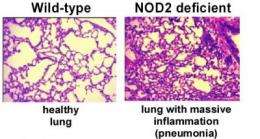Microbiologists find defense molecule that senses respiratory viruses

A cellular molecule that not only can sense two common respiratory viruses but also can direct cells to mount a defense has been identified by microbiologists at The University of Texas Health Science Center at San Antonio.
The finding, published online Sunday, Aug. 23, by the journal Nature Immunology, could lead to new therapies for human respiratory syncytial virus (RSV) and influenza A (commonly known as flu), both of which are serious threats to people with weak immune systems, particularly infants up to age 1 and senior citizens age 65 and older.
"This molecule could be used to boost host immune defenses and stimulate vaccine efficacy against RSV and influenza A, especially among high-risk individuals," said senior author Santanu Bose, Ph.D., assistant professor of microbiology and immunology. Dr. Bose's laboratory team includes graduate student Ahmed Sabbath and research scientists Te-Hung Chang and Rosalinda Harnack.
Related to survival
The cellular molecule, called NOD2, recognizes these viruses and can instruct cells to defend against them. Researchers found that mice lacking the sensor survive for only 10 days after infection, compared with up to eight weeks for normal animals.
Identifying this sensor and understanding its key role could result in therapies that activate the NOD2 gene during or prior to infection, leading to enhanced protective immunity. The NOD2 sensor also has the potential to recognize other viruses, such as West Nile virus, yellow fever, Ebola and rabies.
Dr. Bose has multiple grants from the National Institutes of Health and the American Lung Association to continue this line of research. "In the future, studies will gear up to find out if NOD2 is a susceptibility gene for respiratory viruses, since frequent mutation of this gene has been found in humans," he said.
Possible clinical use
Once the study is designed and clinical partner affiliations are reached, the Bose team hopes to draw blood from severely infected, moderately infected and non-infected patients to test for levels of the sensor, which would allow predictions as to how individuals might respond to respiratory viral infections.
"This is a major breakthrough in understanding respiratory virus behavior and innate immune antiviral factors, and provides the basis for innovative therapies to improve host responses to infectious diseases," said Joel Baseman, Ph.D., professor and chairman of microbiology and immunology at the Health Science Center.
Dr. Baseman said microbiology and immunology faculty members in the university's Graduate School of Biomedical Sciences are doing fundamental and translational research that is the basis for the establishment of an airway disease research and vaccine center. The group includes Dr. Bose's co-authors on the NOD2 paper, Peter Dube, Ph.D., and Yan Xiang, Ph.D.
Source: University of Texas Health Science Center at San Antonio














